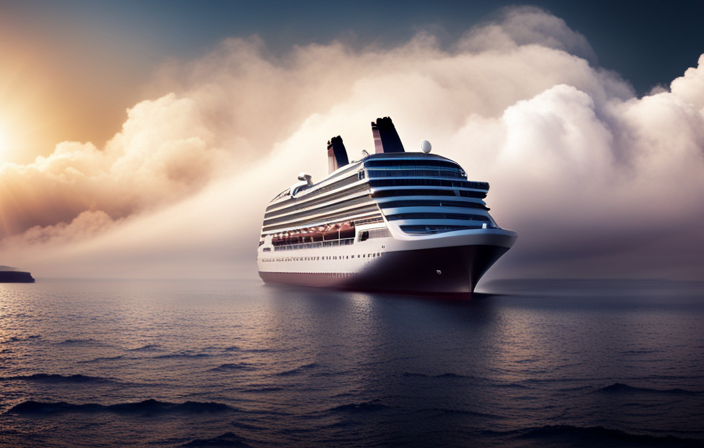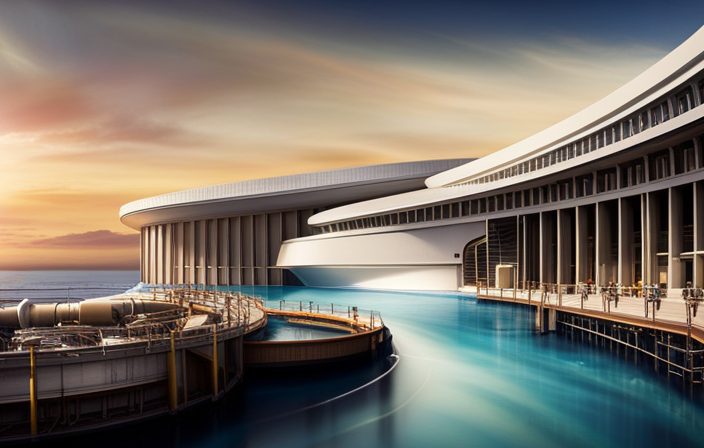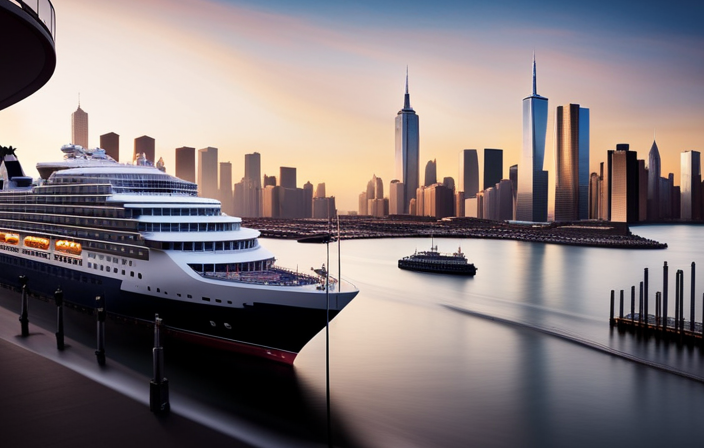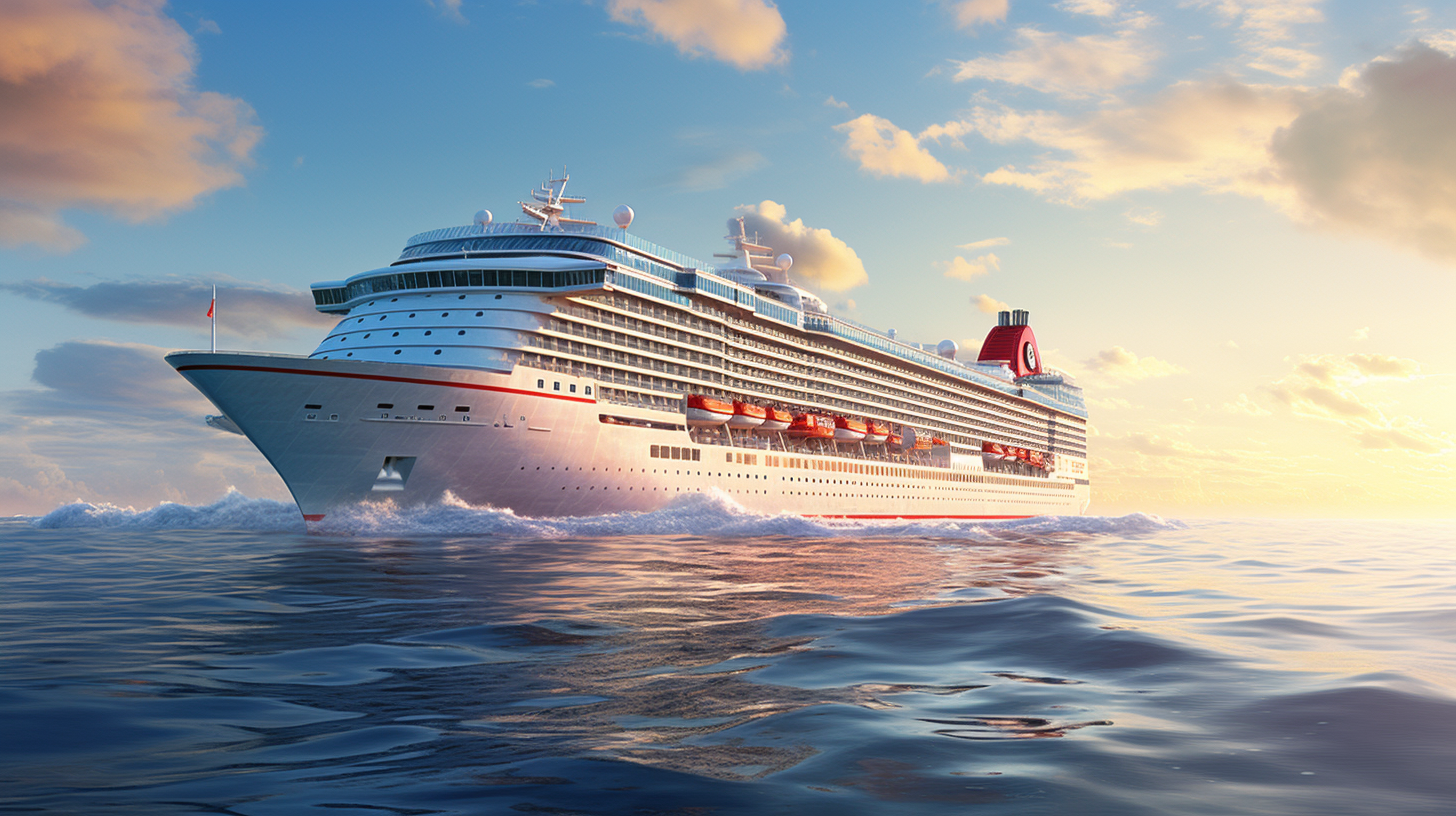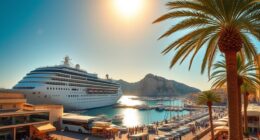Standing on the deck of a massive cruise ship, surrounded by the boundless expanse of the open sea, I am struck by the magnificence of this engineering marvel. The power propelling this gigantic floating city across the waves, along with the fuel that keeps it moving hour after hour, is nearly incomprehensible. In this article, we’re going to dive into the fascinating world of how much fuel these behemoths of the seas consume every hour, focusing on the intriguing topic of cruise ship fuel consumption.
With their immense size and countless amenities, cruise ships require an extraordinary amount of fuel to operate. We will uncover the environmental impact of this fuel consumption, discussing the emissions and regulatory measures that have been put in place to mitigate the harm.
Additionally, we will explore the technological advancements that have led to improved fuel efficiency, as well as the responsibility of passengers to make informed and sustainable travel choices.
Join me on this journey as we unravel the complexities of cruise ship fuel consumption, and discover the path towards a greener future on the high seas.
Key Takeaways
- Cruise ships are massive and require a significant amount of fuel for propulsion, leading to increased emissions and air pollution.
- Advanced propulsion systems and onboard power management systems contribute to fuel efficiency, reducing the environmental impact of cruise ships.
- Cruise lines are exploring alternative fuels like LNG and biofuels, which have lower carbon emissions, to mitigate harm to the environment.
- Energy-saving technologies, such as LED lighting and waste heat recovery, are implemented on cruise ships to reduce energy consumption and improve fuel efficiency.
The Size and Power of Cruise Ships
Cruise ships are massive and pack a ton of power, making them a thrilling sight to behold on the open seas. Their size is truly impressive, with some ships stretching over 1,000 feet long and accommodating thousands of passengers. This size allows for the inclusion of numerous amenities, such as restaurants, theaters, and swimming pools, which contribute to the overall appeal of these floating resorts.
However, the size of cruise ships also affects their fuel efficiency. The larger the ship, the more fuel it requires to propel itself through the water. This has both economic and environmental implications. Cruise ships consume a significant amount of fuel per hour, impacting not only the cost of operating the ship but also the local economies that rely on tourism. Furthermore, the high fuel consumption leads to increased emissions, contributing to air pollution and climate change.
As we delve into the topic of fuel consumption and emissions, we will explore the strategies employed by cruise ships to mitigate their environmental impact.
Fuel Consumption and Emissions
Enjoying a leisurely voyage on a cruise liner, you’ll be amazed at the efficient energy consumption and emissions management in place. Here are some key factors contributing to the fuel efficiency of cruise ships and the use of alternative fuels:
-
Advanced Propulsion Systems: Cruise ships are equipped with state-of-the-art propulsion systems that optimize fuel consumption. These systems include highly efficient engines, advanced hull designs, and energy recovery systems.
-
Onboard Power Management: Cruise ships utilize sophisticated power management systems to minimize energy waste. These systems monitor and control the distribution of electricity, ensuring that it is used efficiently throughout the vessel.
-
Alternative Fuels: Many cruise lines are actively exploring the use of alternative fuels, such as liquefied natural gas (LNG) and biofuels. These fuels have lower carbon emissions compared to traditional marine fuels, contributing to a more sustainable cruising experience.
-
Energy-saving Technologies: Cruise ships are equipped with energy-saving technologies, such as LED lighting, smart HVAC systems, and waste heat recovery systems. These technologies reduce energy consumption and contribute to overall fuel efficiency.
As we delve into the subsequent section about the environmental impact of cruise ship fuel consumption, we will explore the various measures taken to mitigate any potential negative effects.
Environmental Impact of Cruise Ship Fuel Consumption
When discussing the environmental impact of cruise ship fuel consumption, there are three key points that must be considered:
-
Air pollution and greenhouse gas emissions: The burning of fuel on cruise ships releases large amounts of pollutants into the air, contributing to air pollution and the greenhouse effect. This has detrimental effects on both human health and the environment.
-
Water pollution and oil spills: The discharge of wastewater and the potential for oil spills pose significant risks to water quality and marine habitats. Cruise ships generate a substantial amount of wastewater, which can contain harmful chemicals and pollutants. In the event of an oil spill, the damage to marine ecosystems can be catastrophic.
-
Impact on marine life and ecosystems: The noise pollution and physical disturbances caused by cruise ships can disrupt the delicate balance of marine ecosystems and harm marine life. Marine animals rely on sound for communication, navigation, and finding food. The constant noise from cruise ships can interfere with these essential activities, leading to negative consequences for marine life.
These three factors highlight the significant environmental impact of cruise ship fuel consumption. It is crucial to address these issues and find sustainable solutions to minimize the negative effects on our planet’s ecosystems.
Air Pollution and Greenhouse Gas Emissions
Despite the luxury and grandeur of cruise ships, their significant contribution to air pollution and greenhouse gas emissions cannot be ignored. Cruise ships are responsible for emitting large amounts of pollutants into the atmosphere, including sulfur dioxide, nitrogen oxides, and particulate matter.
This pollution has detrimental effects on air quality, human health, and the environment. To address this issue, air quality regulations have been implemented to limit the emissions from cruise ships. Additionally, cruise lines are exploring alternative fuels such as liquefied natural gas (LNG) and hydrogen to reduce their environmental impact.
These efforts aim to minimize air pollution and mitigate the greenhouse gas emissions associated with cruise ship operations. Transitioning to the next section about water pollution and oil spills, it is essential to understand the interconnectedness of these environmental concerns.
Water Pollution and Oil Spills
Cruise ships, like floating time bombs, have the potential to unleash devastating water pollution and oil spills. The sheer volume of fuel these vessels consume per hour contributes to water contamination and marine ecosystem devastation.
When cruise ships burn heavy fuel oil, harmful pollutants such as sulfur dioxide and nitrogen oxide are released into the air. These pollutants can then settle on the ocean surface, causing water contamination.
Additionally, the risk of oil spills is a constant concern. Accidental spills can occur during refueling operations or as a result of equipment failure. These oil spills can have catastrophic effects on marine life and ecosystems, leading to long-term damage.
Transitioning to the subsequent section about marine life and ecosystems, it is crucial to understand the impact of these pollutants on the delicate balance of our oceans.
Marine Life and Ecosystems
Explore the vibrant world of marine life and ecosystems that thrive beneath the ocean’s surface. The delicate balance of these ecosystems is crucial for marine conservation and biodiversity preservation. Here are four key aspects that highlight the importance of protecting these environments:
-
Species Interdependence: Marine ecosystems rely on the interdependence of various species, such as coral reefs providing shelter for fish and other organisms.
-
Nutrient Cycling: These ecosystems play a vital role in nutrient cycling, as marine organisms recycle nutrients and maintain the balance of the food chain.
-
Carbon Sequestration: Marine life helps mitigate climate change by absorbing and storing carbon dioxide, playing a critical role in the global carbon cycle.
-
Economic Value: These ecosystems provide valuable resources, such as fisheries and tourism, contributing to the economy while supporting local communities.
Understanding the significance of marine conservation and biodiversity preservation is crucial for maintaining the health and sustainability of these ecosystems.
Transitioning to the subsequent section about regulatory measures and international standards, it is important to examine the steps taken to protect and regulate these valuable marine resources.
Regulatory Measures and International Standards
International regulations and standards have had a significant impact on the fuel usage of cruise ships. The International Maritime Organization (IMO) has implemented various measures to reduce air pollution and greenhouse gas emissions. One of these measures is the Energy Efficiency Design Index (EEDI), which sets fuel efficiency standards for new ships. Another measure is the Ship Energy Efficiency Management Plan (SEEMP), which requires ships to develop strategies for improving energy efficiency. Additionally, the IMO has implemented sulfur emission limits, which require ships to use low-sulfur fuel or exhaust gas cleaning systems. These regulatory measures have led to a significant reduction in fuel consumption and emissions from cruise ships.
Moving on to the next section on technological advancements in fuel efficiency, it is clear that these regulations have driven the industry to seek innovative solutions for further reducing fuel consumption.
Technological Advancements in Fuel Efficiency
It’s incredible how international regulations have sparked a wave of technological advancements in fuel efficiency for ships. Fuel saving technologies have emerged as a result, helping cruise ships reduce their fuel consumption and carbon emissions.
These technologies include advanced hull designs, such as air lubrication systems and bulbous bows, which minimize drag and improve fuel efficiency.
Additionally, the use of alternative fuel options, such as liquefied natural gas (LNG) and biofuels, has gained traction in the industry. LNG, in particular, offers significant environmental benefits by reducing sulfur oxide and particulate matter emissions.
The development of hybrid propulsion systems, combining traditional fuels with electric power, further enhances fuel efficiency.
As we transition into the subsequent section on corporate responsibility and sustainability initiatives, it is clear that the maritime industry is actively seeking ways to minimize its environmental impact and embrace a greener future.
Corporate Responsibility and Sustainability Initiatives
Cruise line companies have made significant commitments to environmental protection. They focus on reducing their carbon footprint and preserving the ecosystems they traverse. These initiatives include investing in advanced waste management and recycling programs to minimize pollution and promote sustainability.
Additionally, cruise lines actively engage with local communities. They participate in conservation projects to contribute positively to the regions they visit.
Cruise Line Commitments to Environmental Protection
Passengers aboard cruise ships may be astounded by the sheer amount of fuel these floating cities devour per hour. However, cruise line initiatives and environmental regulations have prompted a commitment to environmental protection.
Cruise lines have taken significant measures to reduce their environmental impact. They have invested in advanced technologies, such as more efficient engines and innovative hull designs, to optimize fuel consumption. Additionally, they adhere to strict environmental regulations, including emission control and waste management practices.
Cruise lines have established robust waste management and recycling programs onboard. These programs aim to minimize waste generation, promote recycling, and ensure proper disposal of hazardous materials.
By implementing these initiatives, cruise lines are actively working towards a more sustainable and environmentally friendly operation. As we transition into the next section discussing waste management and recycling programs, it is evident that cruise lines are taking proactive steps to address environmental concerns.
Waste Management and Recycling Programs
Amidst the astounding fuel consumption, cruise lines have implemented waste management and recycling programs to address environmental concerns. These waste management strategies aim to minimize the environmental impact of cruise ship operations.
One key aspect of these programs is the proper handling and disposal of waste generated onboard the ships. Cruise lines have implemented strict protocols for waste segregation, ensuring that recyclable materials are separated from non-recyclable ones.
Recycling initiatives have also been put in place to manage and process the recyclable waste. This includes the collection and sorting of materials such as paper, plastic, glass, and metal.
By implementing these waste management and recycling programs, cruise lines contribute to the reduction of waste sent to landfills and promote a more sustainable approach to cruising. Moving forward, these efforts can be further enhanced through community engagement and conservation projects.
Community Engagement and Conservation Projects
Engaging with local communities and implementing conservation projects, cruise lines have taken steps to promote sustainable practices and protect the environment. This commitment to community engagement is evident through their involvement in various conservation projects.
-
Coastal Cleanup Programs: Cruise lines organize regular coastal cleanup programs. Crew members and passengers join forces to remove litter and debris from beaches and coastal areas. These efforts help preserve the natural beauty of these destinations and protect marine life from the harmful effects of pollution.
-
Wildlife Conservation Initiatives: Cruise lines collaborate with local organizations to support wildlife conservation efforts. This includes initiatives such as protecting nesting sites for endangered species, conducting research on marine mammals, and implementing measures to reduce the impact of cruise activities on sensitive ecosystems.
-
Educational Outreach Programs: Cruise lines actively engage with local communities by organizing educational outreach programs. These programs aim to raise awareness about environmental issues and promote sustainable practices among residents and visitors alike.
By actively participating in community engagement and implementing conservation projects, cruise lines strive to create a positive impact on the environment and encourage responsible travel choices among passengers.
Passenger Awareness and Responsible Travel Choices
When considering responsible travel choices as a passenger, there are several key points to keep in mind.
Firstly, it’s important to choose sustainable cruise lines that prioritize environmental conservation and minimize their carbon footprint.
Secondly, offsetting carbon footprints is crucial to counteract the emissions generated by cruising, and can be done through various programs or organizations.
Lastly, participating in shore excursions with positive impacts, such as supporting local communities or engaging in conservation efforts, can contribute to the overall sustainability of the cruise experience.
Choosing Sustainable Cruise Lines
Many sustainable cruise lines are committed to minimizing their fuel consumption per hour. In order to promote sustainable tourism and eco-friendly practices, these cruise lines have implemented various measures to reduce their environmental impact.
One of the key strategies is the use of advanced technology and fuel-efficient engines. These engines are designed to optimize fuel consumption and reduce emissions. Additionally, sustainable cruise lines prioritize the use of alternative fuels such as liquefied natural gas (LNG) or biodiesel, which have lower carbon footprints compared to traditional fossil fuels. They also invest in energy-efficient systems and practices on board, such as LED lighting and waste management systems.
By adopting these sustainable practices, cruise lines aim to minimize their environmental impact and provide passengers with responsible travel options.
Transitioning into the subsequent section about offsetting carbon footprints, sustainable cruise lines also actively seek ways to offset their emissions through initiatives such as carbon offset programs and partnerships with environmental organizations.
Offsetting Carbon Footprints
Can sustainable cruise lines effectively offset their carbon footprints and contribute to a greener future?
While it is true that cruise ships emit a significant amount of carbon dioxide, many sustainable cruise lines are taking proactive steps to offset their carbon footprints.
These offsetting initiatives often involve participating in carbon offset programs, which aim to neutralize the environmental impact of cruise ship emissions.
Some cruise lines invest in renewable energy projects, such as wind or solar farms, to offset their carbon emissions.
Others support reforestation efforts or invest in sustainable development projects.
By participating in these carbon offset programs, sustainable cruise lines can make a tangible difference in reducing their environmental impact.
Transitioning into the next section, participating in shore excursions with positive impacts is another important step towards a greener future.
Participating in Shore Excursions with Positive Impacts
To fully embrace a greener future, you can join shore excursions that have positive impacts. This allows you to contribute to sustainable practices while enjoying your cruise experience.
Participating in these shore excursions not only enhances your vacation but also provides an opportunity to make a difference. By choosing responsible tourism, you can support local communities, promote cultural preservation, and minimize environmental impacts.
These excursions often focus on activities such as beach clean-ups, wildlife conservation, and sustainable farming practices. By engaging in these activities, you can directly contribute to the reduction of negative shore excursion impacts and help create a positive change in the destinations you visit.
By actively participating in responsible tourism, you can be part of the solution for a more sustainable cruise industry.
Looking ahead, future trends in cruise ship fuel consumption will continue to shape the industry’s efforts towards reducing environmental impact.
Future Trends in Cruise Ship Fuel Consumption
You’ll be amazed at the potential for reducing fuel consumption in future cruise ships. With advancements in future technology and the increasing demand for sustainable travel, cruise lines are exploring alternative fuels to power their vessels.
One promising technology is the use of LNG (liquefied natural gas), which emits significantly fewer greenhouse gases compared to traditional marine fuels.
In addition, hydrogen fuel cells are being considered as a clean energy source for cruise ships. These cells produce electricity by combining hydrogen and oxygen, with only water as a byproduct.
By incorporating these future technologies and alternative fuels, cruise ships have the potential to significantly reduce their fuel consumption and carbon emissions.
This shift towards sustainable practices not only benefits the environment but also responds to the growing public perception and pressure for change.
Public Perception and Pressure for Change
Imagine yourself on a crowded beach, surrounded by people passionately waving their eco-friendly flags and chanting for change in the cruise industry. The public opinion has shifted, and there is mounting pressure on cruise ship companies to reduce their fuel consumption and carbon emissions.
Government regulations are also becoming stricter, forcing these companies to take action.
To understand the deeper meaning behind this public perception and pressure for change, consider the following:
- Increasing awareness of the environmental impact of cruise ships
- Concerns over air and water pollution caused by cruise ship operations
- The desire for a more sustainable and responsible tourism industry
- Calls for transparency and accountability from cruise ship companies
- The potential economic benefits of transitioning to greener practices
With all these factors in play, the cruise industry is being pushed towards a greener future. Transitioning to more fuel-efficient technologies and adopting sustainable practices will be key in meeting these demands.
The Path to a Greener Future
Get ready to embark on a journey towards a greener future as we explore the path to reducing the environmental impact of the cruise industry. One of the key ways to achieve this is through the adoption of greener transportation and the use of renewable energy sources. Cruise ships can significantly reduce their carbon emissions by transitioning to cleaner fuel options such as liquefied natural gas (LNG) or biofuels. Additionally, integrating solar and wind power systems can further decrease the reliance on fossil fuels during sailing. To illustrate the potential benefits of these changes, consider the following table:
| Fuel Type | CO2 Emissions (per hour) | SOx Emissions (per hour) | NOx Emissions (per hour) |
|---|---|---|---|
| Conventional Fuel | 10 tons | 10 kg | 100 kg |
| Liquefied Natural Gas (LNG) | 6 tons | 0 kg | 80 kg |
| Biofuels | 8 tons | 0 kg | 90 kg |
By transitioning to greener transportation and utilizing renewable energy sources, the cruise industry can make significant strides in reducing its environmental impact and contributing to a more sustainable future.
Frequently Asked Questions
What are the main factors that contribute to the fuel consumption of a cruise ship?
Factors that contribute to fuel consumption of cruise ships include ship size, speed, and itinerary. Larger ships consume more fuel, while faster speeds and longer distances traveled also increase fuel usage.
How does the fuel consumption of a cruise ship compare to other modes of transportation?
When comparing the fuel consumption of a cruise ship to air travel, it is evident that cruise ships consume significantly more fuel. This has a profound impact on marine ecosystems due to emissions and the potential for oil spills.
Are there any alternative fuels being used or considered for cruise ships to reduce their environmental impact?
There are several alternative fuels being considered for cruise ships to reduce their environmental impact. These include liquefied natural gas (LNG), hydrogen fuel cells, and biofuels. These options aim to decrease emissions and promote sustainability in the cruise industry.
What measures are cruise ship companies taking to reduce their fuel consumption and emissions?
Cruise ship companies are implementing sustainable initiatives and adopting technological advancements to reduce fuel consumption and emissions. These measures include using cleaner fuels, optimizing ship design for efficiency, and employing advanced propulsion systems.
How do cruise ship companies ensure that their passengers are aware of the environmental impact of their travel choices and encourage responsible behavior?
Cruise ship sustainability initiatives focus on passenger education to create awareness about the environmental impact of their travel choices. This is done through informational sessions, onboard materials, and interactive activities, encouraging responsible behavior and minimizing negative effects on the environment.
Does the Fuel Efficiency of a Cruise Ship Determine How Far it Can Travel Without Refueling?
Yes, the fuel efficiency of a cruise ship directly impacts its refueling range. The better the fuel efficiency, the farther the ship can travel without needing to refuel. This is an important factor for cruise ship operators to consider when planning itineraries and managing costs.
Conclusion
In conclusion, the fuel consumption of cruise ships is a critical issue that demands immediate attention. These floating giants contribute significantly to greenhouse gas emissions and environmental degradation, with an average consumption of 150 tons per day.
However, the recent case study of Royal Caribbean’s Symphony of the Seas showcases the potential for change. By incorporating advanced technologies like LNG propulsion and implementing energy-efficient practices, this ship has reduced its fuel consumption by 20%.
Such success stories should inspire the industry to prioritize sustainable practices, ensuring a greener future for our oceans.
Alfons is the visionary leader and driving force behind Voyager Info’s success. As the Editor in Chief, he brings a wealth of experience and an unwavering passion for travel to the helm of our cruise-centric platform.
With a lifelong fascination for exploring new horizons, Alfons discovered his love for the ocean and cruising at a young age. From sailing across pristine Caribbean waters to embarking on daring expeditions to far-flung destinations, he has amassed a treasure trove of first-hand experiences in the world of cruising.

